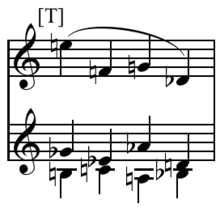
Arnold Schoenberg's Suite for Piano (German: Suite für Klavier), Op. 25, is a 12-tone piece for piano composed between 1921 and 1923. The work is the earliest in which Schoenberg employs a row of "12 tones related only to one another" in every movement:[citation needed] the earlier 5 Stücke, Op. 23 (1920–23) employs a 12-tone row only in the final waltz movement, and the Serenade, Op. 24, uses a single row in its central Sonnet. The basic tone row of the suite consists of the following pitches: E–F–G–D♭–G♭–E♭–A♭–D–B–C–A–B♭.
In form and style, the work echoes many features of the Baroque suite. There are six movements:
- Präludium (1921)
- Gavotte (1923)
- Musette (1923)
- Intermezzo (1921–1923)
- Menuett. Trio (1923)
- Gigue (1923)
A typical performance of the entire suite takes around 16 minutes.
In this work, Schoenberg employs transpositions and inversions of the row for the first time: the sets employed are P-0, I-0, P-6, I-6 and their retrogrades. Arnold Whittall has suggested that "[t]he choice of transpositions at the sixth semitone—the tritone—may seem the consequence of a desire to hint at 'tonic-dominant' relationships, and the occurrence of the tritone G–D♭ in all four sets is a hierarchical feature which Schoenberg exploits in several places".[2]
The suite was first performed by Schoenberg's pupil Eduard Steuermann in Vienna on 25 February 1924. Steuermann made a commercial recording of the work in 1957.[3] The first recording of the Suite for Piano to be released was made by Niels Viggo Bentzon some time before 1950.[3]
The Gavotte movement contains, "a parody of a baroque keyboard suite that involves the cryptogram of Bach's name as an important harmonic and melodic device[4][5] and a related quotation of Schoenberg's Op. 19/vi.[6]
Edward T. Cone (1972) has catalogued what he believes to be a number of mistakes in Reinhold Brinkmann's 1968 revised edition of Schoenberg's piano music, one of which is in measure number five of the Suite's "Gavotte", G♭ instead of G♮.[7] Henry Klumpenhouwer invokes Sigmund Freud's concept of parapraxes (i.e., mental slips) to suggest a psychological context explaining the deviation from the note predicted from the tone row.[8]